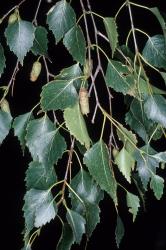- Taxon
- Weed
- Gallery
- = Betula verrucosa Ehrh. (1790)
Tree to c. 25 m high; branchlets slender, often semi-drooping. Bark smooth at first, silvery-white and papery, usually becoming dark grey and rough at least on lower trunk. Shoots glabrous, ± glandular-resinous, prominently lenticellate and appearing warty. Petiole slender, mostly 7–25 mm long. Lamina 3–6 × 1.5–5.5 cm, deltoid, ovate or rhombic-ovate, glabrous, with 5–7 pairs of veins, glandular-resinous when young, coarsely and doubly serrate; base subcordate, truncate or broadly cuneate; apex acuminate. ♂ catkins 2–9 cm long; bract 2–3 mm long, shield-like, both bract and bracteoles ciliolate. ♀ catkins 1.5–2.5 cm long, scarcely elongating at fruiting but becoming broadly cyclindric and c. 0.7 cm wide. Stigmas rose. Scales 3.5–4.5 × 4–5 mm, puberulent; lateral lobes broader and rounder than middle lobe, widespreading and often ± downward curving. Fr. 1.5–2.5 mm long; wing much > fr.
[From: Webb et al. (1988) Flora of New Zealand. Volume 4.]
Flowering: Sep.–Nov.




